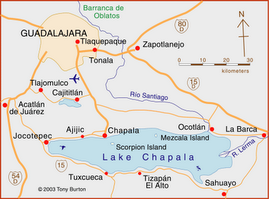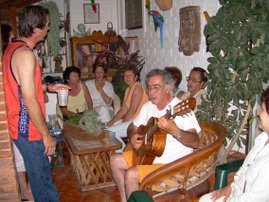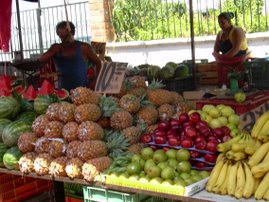 Our youngest daughter, Cassie, finally arrived for a visit in Mexico after being unable to get out of Boston at Christmas because of the huge snowstorm. She had been in Fort Worth Texas the previous week for a week-long session for her MFA program in Illustration through Hartford Art School. She is finishing up her program, so she arrived here exhausted and with lots of drawing and writing to do to finish up her thesis. We didn't do much very exciting, but we did have a wonderful visit. The above photo of Cassie was taken at the Balneario in San Juan Cosala. It is a facility with swimming pools, hot tubs, saunas, and spa services. The waters are mineral, thermal baths, heated by the volcanic activity in this area. The Balneario is a popular relaxing spot for many Mexicans, and it is one of our favorite places to visit. In fact I was "ordered" by my orthopedic doctor to soak in the hot tub and exercise my shoulder there once a week when I was doing physical therapy for my torn rotator cuff last fall.
Our youngest daughter, Cassie, finally arrived for a visit in Mexico after being unable to get out of Boston at Christmas because of the huge snowstorm. She had been in Fort Worth Texas the previous week for a week-long session for her MFA program in Illustration through Hartford Art School. She is finishing up her program, so she arrived here exhausted and with lots of drawing and writing to do to finish up her thesis. We didn't do much very exciting, but we did have a wonderful visit. The above photo of Cassie was taken at the Balneario in San Juan Cosala. It is a facility with swimming pools, hot tubs, saunas, and spa services. The waters are mineral, thermal baths, heated by the volcanic activity in this area. The Balneario is a popular relaxing spot for many Mexicans, and it is one of our favorite places to visit. In fact I was "ordered" by my orthopedic doctor to soak in the hot tub and exercise my shoulder there once a week when I was doing physical therapy for my torn rotator cuff last fall.Cassie forgot her camera, so borrowed ours while she was here. She has a different eye, so I thought I'd share some of her photos. These photos are from the malecon (paved walkway with vendors) area of Chapala:


Here are some of her views of Ajijic, perhaps different from the ones I might take:









So there you have a "Cassie's eye view" of our area of Mexico. Of course, mostly what we saw of Cassie was her working hard, for many hours, on her drawings:
 So, now she's returned to Providence with her partner, Alana, and her new puppy, Yote. They are relocating to Maine this spring, and Cassie will be completing her program at Hartford in July. Alana is starting her program at USM to become a nurse practitioner. Cassie starts her new job at a preschool for autistic children in the middle of this month. Needless to say, she will be very busy!
So, now she's returned to Providence with her partner, Alana, and her new puppy, Yote. They are relocating to Maine this spring, and Cassie will be completing her program at Hartford in July. Alana is starting her program at USM to become a nurse practitioner. Cassie starts her new job at a preschool for autistic children in the middle of this month. Needless to say, she will be very busy!This is a sad time of year for us as we are forced to say adios to many of our friends who are here only for the winter months. This was the case with two friends, Ron and Jean from Kennebunkport, who left yesterday. They were staying at the Casa del Sol B&B helping out Cathy Roberts who also relocated here from Maine. I attended a reception for them At Cathy's B&B. From the left, Cathy, Jean, and Ron:
 Fortunately, we'll get to see Ron and jean this July when we visit Maine, and they have already made arrangements to return next winter.
Fortunately, we'll get to see Ron and jean this July when we visit Maine, and they have already made arrangements to return next winter. So, as the snowbirds leave, we are left with the blooming Jacaranda trees, which are beautiful but intensify pollen and allergy symptoms for people like me. The weather is turning decidedly warmer, and will be quite hot in another couple of weeks, until the June rains come and cool things off. This is Holy Week (Semana Santa) here and the restaurants and thermal baths are crowded with vacationing Mexicans. We are going to have our annual flower communion at our fellowship on Sunday then attend a Mexican buffet and mariachi concert at a local hotel for Easter.


















































































































